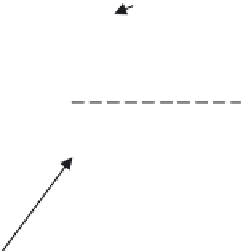Environmental Engineering Reference
In-Depth Information
Downstream
Face B
Upstream
Face A
Angle of bevel
Axial centerline
Flow
D
d
Downstream edge
Dam height
Upstream edge
figure 2.23 Orifice plate.
pipe. Typically, a sharp-edged hole is bored in the center of the orifice
plate. As the flowing water passes through the orifice, the restriction
causes an increase in velocity. A concurrent decrease in pressure occurs
as potential energy (static pressure) is converted into kinetic energy
(velocity). As the water leaves the orifice, its velocity decreases and its
pressure increases as kinetic energy is converted back into potential
energy according to the law of conservation of energy. However, there
is always some permanent pressure loss due to friction, and the loss is
a function of the ratio of the diameter of the orifice bore (
d
) to the pipe
diameter (
d
). For dirty water applications (i.e., wastewater), a concen-
tric orifice plate will eventually have impaired performance due to dirt
buildup at the plate.
eccentric
or
segmental
orifice plates (see Figure
2.24) can be used, but measurements are typically less accurate than
those obtained from the concentric orifice plate, so they are rarely
applied in current practice. The orifice differential pressure flow meter
is the lowest cost differential flow meter, is easy to install, and has no
moving parts; however, it also has high permanent head loss (ranging
from 40 to 90%), higher pumping costs, and an accuracy of ±2% for a flow
range of 4:1, and it is affected by wear or damage.
Note:
Orifice meters are not recommended for permanent installation to
measure wastewater flow; solids in the water easily catch on the orifice,
throwing off accuracy. For installation, it is necessary to have ten diam-
eters of straight pipe ahead of the orifice meter, to create a smooth flow
pattern, and five diameters of straight pipe on the discharge side.
Concentric
Eccentric
Segmental
figure 2.24 Orifice plates.


























